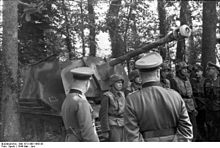- Marder I
-
Marder I 
Marder I on display at the Musée des Blindés at Saumur.Type Tank destroyer Place of origin  Nazi Germany
Nazi GermanyService history In service 1942 to 1944 Used by Nazi Germany Wars World War II Production history Designed 1942 Number built 170 Specifications Weight 8,200 kg (18,078 lbs) Length 5.38 m (17 ft 8 in) Width 1.88 m (6 ft 2 in) Height 2 m (6 ft 7 in) Crew 4 to 5 Main
armament7.5 cm PaK 40 Engine Delahaye 103TT
70 PS (69 hp, 51.5 kW)Operational
range135-150 km (84-93 mi) road Speed 34-38 km/h (21-23 mph) road
15-20 km/h (9-12 mph) off-roadThe Marder I "Marten" (SdKfz 135) was a German World War II tank destroyer, armed with the 75 mm anti-tank gun. Most Marder I's were built on the base of the Tracteur Blindé 37L (Lorraine), a French artillery tractor/armoured personnel carrier of which the Germans had acquired more than three hundred after the Fall of France in 1940.
Contents
History
In the early stages of Operation Barbarossa, the Wehrmacht felt the need for a more mobile and more powerful anti-tank solution than the existing towed anti-tank guns or self-propelled tank destroyers such as the Panzerjäger I. This need became urgent in late 1941, with the appearance of the new Soviet tanks like the T-34 and Kliment Voroshilov.
As an interim solution, Germany decided to use both obsolete tanks like the Panzer II and captured vehicles like the Lorraine as the base for makeshift tank destroyers. The result was the Marder series, which were armed with either the 75 mm PaK 40 anti-tank guns or the captured Soviet 76.2mm F-22 Model 1936 divisional field gun, of which large numbers had been captured.
Development
The Marder I was developed in May 1942 and carried the 75 mm PaK 40 anti-tank gun on a Lorraine chassis. The original crew compartment superstructure was removed and the gun placed on top of the chassis. Around this a new, open-topped compartment was built, to give the gun and crew some protection from small arms fire.
Between July and August 1942, 170 Marder I's were built on the Lorraine chassis. Several other French and Polish tanks were also used as a conversion base for the Marder I, including the Hotchkiss H39 and FCM 36, though these were only built in small numbers.
Combat history
The first Lorraine-based Marder I vehicles were sent to the Eastern Front in 1942 to serve in the Panzerjäger (tank destroyer) units of infantry divisions.
This is a list of Infantry Divisions operating on the Eastern Front known to have used Marder I's and the estimated time frame they were used
Division Battalion Time Frame 31.Inf. Div Pz. Jg.Abt.31 Aug 42 - Dec 43 35.Inf. Div 2.Kp./Pz. Jg.Abt.35 Sep 42 - Dec 43 36.Inf. Div (mot) 4.Kp./Pz. Jg.Abt.38 Oct 42 - Jun 43 72.Inf. Div 3.Kp./Pz. Jg.Abt.72 Sep 42 - Dec 43 206th Inf. Div. 1./Pz. Jg.Schn. Abt.206 Jan 43 - Dec 43 256.Inf. Div 5./Pz. Schnelle-Abt.256 Nov 42 - Apr 44 References
- http://www.achtungpanzer.com/marder-marten-series.htm
- Pz. Jäg. Lr. S. für 7.5 cm Pak 40/1 (Sd. Kfz. 135) (U.S. Intelligence Report)
Tanks Panzer I · Panzer II · Panzer III · Panzer IV · Panther · Tiger I · Tiger II · Panzer 35(t) · Panzer 38(t)Self-propelled artillery Assault guns Tank destroyers Panzerjäger I · Marder I , II , III · RSO/PaK 40 · Nashorn · Elefant · Jagdpanzer IV · Hetzer · Jagdpanther · JagdtigerHalf-tracks Armored cars Self-propelled anti-aircraft guns Prototypes Panzer VIII Maus · E- series · Panther II · Heuschrecke 10 · Neubaufahrzeug · Sturer Emil · 10.5 cm K (gp.Sfl.) · Pz.Sfl. II · Flakpanzer Coelian · KugelpanzerProposed designs Categories:- World War II tank destroyers of Germany
Wikimedia Foundation. 2010.


